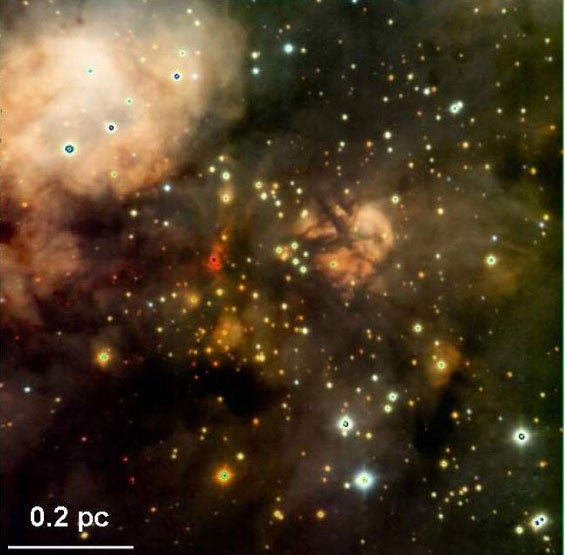Tricolor composite image of W3 Main where massive stars are being born. Red colored objects to the left of center are extremely young massive stars, surrounded by less massive stars of one million years old. Nebulas with a variety of colors and appearances are ionized gas reflecting light from these stars. Filamentary dark clouds are also conspicuous. The line at bottom left shows a scale of 0.2 parsecs, which is approximately 40 thousand astronomical units.
National Astronomical Observatory of Japan
January 29, 2009
To explore dim, distant, low mass stars, a team of Japanese and Indian astronomers used the high sensitivity and spatial resolution of the Cooled Infrared Spectrograph and Camera for OHS (CISCO) at the Subaru Telescope in Hilo, Hawaii, to obtain unprecedented detailed data toward the W3 Main star forming region. W3 Main, located approximately 6,000 light-years away in the constellation Cassiopeia, is a very active and massive star-forming region. To date, this near-infrared image (at right) is the deepest and finest image from a ground-based telescope among the images of massive star forming regions. The deep and high-resolution image shows distinctive reddish and bluish nebulosity features, dark filaments between the diffuse nebulosities, and a significant population of faint stars in W3 Main.
To explore dim, distant, low mass stars, a team of Japanese and Indian astronomers used the high sensitivity and spatial resolution of the Cooled Infrared Spectrograph and Camera for OHS (CISCO) at the Subaru Telescope in Hilo, Hawaii, to obtain unprecedented detailed data toward the W3 Main star forming region. W3 Main, located approximately 6,000 light-years away in the constellation Cassiopeia, is a very active and massive star-forming region. To date, this near-infrared image (at right) is the deepest and finest image from a ground-based telescope among the images of massive star forming regions. The deep and high-resolution image shows distinctive reddish and bluish nebulosity features, dark filaments between the diffuse nebulosities, and a significant population of faint stars in W3 Main.
The study has shown for the first time that there is a significant number of brown dwarfs in the W3 Main star forming region. This result is significantly different from that obtained in the cases of Trapezium and IC 348, where a decrease of relative population of brown dwarfs was found. The research findings indicate that a relative number of brown dwarfs may differ among regions in the galaxy. For the future, the team will proceed with the observations toward much more massive star forming regions in remote areas to study whether the results are widespread.










